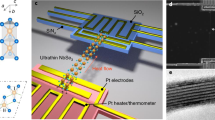Abstract
TESTS have been made recently on a superconducting solenoid constructed from what is believed to be the longest continuous length of niobium–zirconium alloy wire so far produced in the United Kingdom. An ingot of the alloy (75 at. per cent niobium, 25 at. per cent zirconium) was swaged and cold drawn to give approximately 320 feet of 0.010-in. diameter wire. 100 ft. of this was used to construct the coil, which is shown in the accompanying photograph. The insulation was provided by a single layer of silk wrapping round the wire and by sheets of ‘Melinex’ between the layers of the coil.
This is a preview of subscription content, access via your institution
Access options
Subscribe to this journal
Receive 51 print issues and online access
$199.00 per year
only $3.90 per issue
Buy this article
- Purchase on SpringerLink
- Instant access to full article PDF
Prices may be subject to local taxes which are calculated during checkout
Similar content being viewed by others
References
Chandrasekhar, B. S., et al., Eighth Intern. Conf. Low Temperature Physics (preprints, 313) (1962).
Berlincourt, T. G., et al., Phys. Rev. Letters, 6 (12), 671 (1961).
Author information
Authors and Affiliations
Rights and permissions
About this article
Cite this article
WILSON, G., MICHIE, G. & ROBERTS, D. A Superconducting Solenoid. Nature 196, 1306 (1962). https://doi.org/10.1038/1961306a0
Issue date:
DOI: https://doi.org/10.1038/1961306a0



